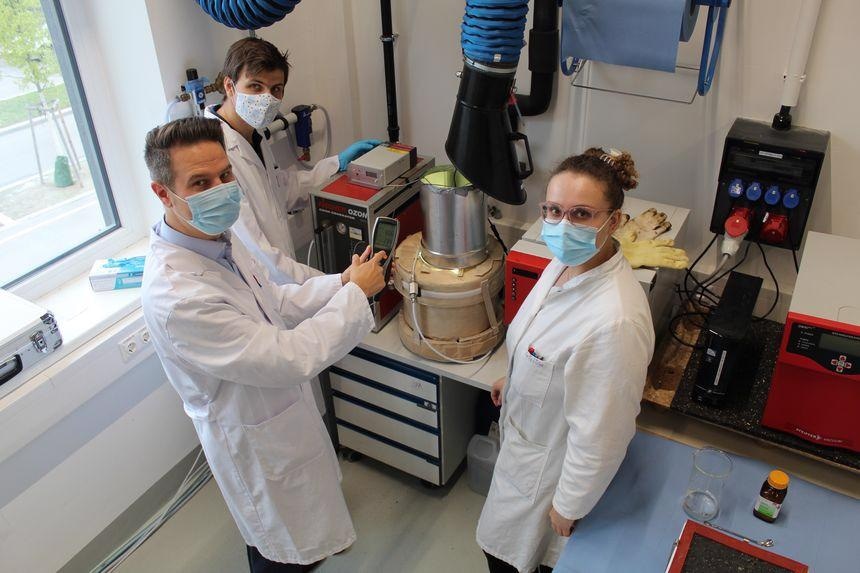Contrary to previous assumptions, a surprising result in road engineering research shows that visible light contributes to the aging of bitumen, which can ultimately damage road pavements. Bitumen is the black binder holding the small stones in asphalt together and thus governs its durability. Aging causes bitumen to change its properties and turn brittle, ultimately leading to asphalt cracking.
 Bernhard Hofko, Johannes Mirwald, and Kristina Hofer (left to right). Image Credit: TU Wien.
Bernhard Hofko, Johannes Mirwald, and Kristina Hofer (left to right). Image Credit: TU Wien.
Researchers from TU Wien (Vienna) have been performing a study to gain better insights into these processes and render asphalt more durable. The study was conducted at the university’s “Christian Doppler Laboratory for Chemo-mechanical Analysis of Bituminous Materials” set up in 2020.
Johannes Mirwald from the Institute of Transportation at TU Wien accidentally came across this intriguing effect: in contrast to previous assumptions, visible light in the blue and green range can make bitumen age more vigorously and in a short period.
TU Wien researchers have now analyzed this light-induced change in bitumen in detail. It is crucial to consider solar radiation in future research and in predicting the life span of roads.
Chance Discovery in the Laboratory
The research project started with some strange observations that nobody could explain at first. We had bitumen samples lying around in glass containers in the laboratory, and on closer examination we noticed that their surface had changed after a relatively short time.
Bernhard Hofko, Professor, Institute of Transportation, TU Wien
Such changes might have been predicted at high temperatures, but not at ambient temperatures in the laboratory. Although intense UV radiation could be regarded to cause such changes, the glass actually absorbs a major portion of the UV radiation and lets only the visible portion through. “So we decided to take a closer look at this strange phenomenon with special microscopes,” added Bernhard Hofko.
The researchers uniquely illuminated bitumen samples, with various accurately defined light colors, ranging from red with a comparatively long wavelength to the UV range with short wavelengths.
Until now, it was assumed that the high-energy UV light had the strongest influence on the ageing of bitumen. Visible light was not expected to have any significant effect.
Johannes Mirwald, Institute of Transportation, TU Wien
However, the measurements clearly revealed that at all the analyzed light wavelengths, variations in the surface of bitumen could already be observed after 15–20 minutes. In fact, although the most powerful effect occurs in the UV range, the effects caused by visible light are equally strong, during an additional maximum in the blue and green light wavelength range.
Considering light conditions on the surface of the earth and the impact of the atmosphere as well, whereby UV light is considerably absorbed more than blue or green light, it is evident that blue light has the most drastic aging effect on road surfaces.
Oxidation Leads to Cracks
The light tends to speed up the material’s oxidation, and the oxidization of bitumen causes a change in its mechanical properties. It turns stiffer and thus more prone to cracking.
Initially, oxidation under the influence of light only takes place in the top layers of the material—in the outermost micrometres of the bitumen sample. But this is merely the initial spark for a far-reaching effect: small cracks ensure that oxygen can penetrate deeper into the material, stresses develop inside the material, the cracks become deeper and ultimately this can lead to lasting damage to the asphalt.
Johannes Mirwald, Institute of Transportation, TU Wien
To date, experiments on bitumen aging have mainly been performed in the dark. This approach will now change. “Our measurements show: If you want to predict the durability of asphalt, then you definitely have to take solar radiation into account,” stated Bernhard Hofko. Furthermore, when the solar radiation is specifically high, it is essential to deal with high temperatures, leading to further intensification of the effect.
“It is an absolutely amazing result that no one had expected — something like this doesn’t happen often in research,” added Hofko. The results of this new study will result in crucial changes for the science of road engineering.
Journal Reference:
Mirwald, J., et al. (2021) Impact of UV–Vis light on the oxidation of bitumen in correlation to solar spectral irradiance data. Construction and Building Materials. doi.org/10.1016/j.conbuildmat.2021.125816.